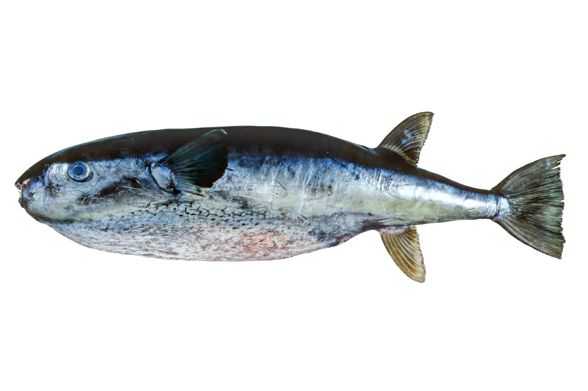Oceanic Puffer

Species Details
Lagocephalus Lagocephalus
Tetraodontidae
Tetraodontiformes
Offshore, Open Ocean
4 - 7 lbs.
20" - 24"
Oceanic Puffer (Lagocephalus lagocephalus) Fish Description
The Oceanic Puffer (Lagocephalus lagocephalus) is a type of pufferfish found in sub-tropical and tropical oceans around the world. This pufferfish looks a lot different than any other of its family because it’s a lot less colorful. This fish can be identified through its blackish-grey to dark bluish-grey coloration on top that sharply turn silver with some black spots on the sides and white on the belly.
The Oceanic Puffer also has an elongated body. Its head is relatively large that is rather blunt and projects to the front. Its eyes are large and elevated while its mouth is small but well equipped with strong powerful teeth. Its triangular dorsal fin is situated almost at the back end, almost in parallel to its anal fin. The caudal or tail fin is rather small with a small base. All its fins are colored dark gray or black with the exception of the anal fin, which is lighter gray in color.
Although the Oceanic Puffer doesn’t have any scales, its skin is rather tough and it’s armed with small spines that run from the chin to the anus on their ventral side. Aside from that, its body is covered in mucus with a potent dose of neurotoxin called Tetrodotoxin, which can actually be fatal if consumed by predators—yes, including humans. And like other pufferfishes, it has the ability to “puff up” or make itself bigger than its normal size by ingesting huge amounts of water (and/or air), which deters predators to attack.
Diet and Size
Oceanic Puffers usually eat crustaceans and squids. Bigger ones, however, are known to eat clams, mussels, and shellfish by cracking the shells with their tough teeth. Although most Oceanic Pufferfish grows to as much as two feet long and weigh as much as seven and a half pounds, there are some unconfirmed sightings of this fish growing more than two feet.
Oceanic Puffer Interesting Facts
- There have been reports of Oceanic Pufferfish reaching two and a half feet in length.
- The Oceanic Pufferfish, like all pufferfish, only has four teeth—two at the top and two at the bottom.
- Its teeth resemble a beak which helps them crack open hard-shelled clams, mussels, and shellfish.
- Pufferfish skin and flesh contain a highly toxic substance called Tetrodotoxin, which can be fatal to humans if ingested.
- The fish’s toxin is so potent that it’s said that a single Oceanic Pufferfish liver can kill thirty human adults.
- Despite the high toxicity of the fish, Pufferfish is a delicacy called fugu in Japan.
- Only licensed chefs who have undergone three years of training can prepare Pufferfish meat.
- Forty-four fugu poisoning have been recorded in Japan between 1996 and 2006.
- Only sharks can eat Pufferfish without any observed negative consequences.
Fishing Tips
Catching an Oceanic Pufferfish is actually quite easy—that is, if you know where to cast your line and you have the right gear to get the job done. For the best location to catch a puffer, just head on out to the deeper waters and employ a bit of clam chumming to attract your target. As for the gear, make sure that you’re equipped with a 5- to 6-foot light-action rod for you to be able to feel the fish’s soft pecks on your bait because, yes, puffers are known to be bait-stealers. You will also need either a small size 8 or 10 hook to fit the puffer’s small mouth. Once you’re able to hook it, reeling it in and landing it is quite easy. A word of warning though—be careful in handling the fish and never attempt to eat it because, as already mentioned, the fish is highly poisonous.
Habitat and Distribution
The Oceanic Pufferfish is a pelagic fish that can be found from the surface up to the middle columns of the open waters of up to three thousand feet in depth. They can also be found in most sub-tropical to tropical waters around the world. In North America, they are most abundant in all Mexican waters of both the Atlantic and the Pacific Oceans; although they can sometimes be found from New Jersey to the coastal Atlantic waters of Florida and the Gulf of Mexico; as well as the southernmost part of the Californian coastal waters.







